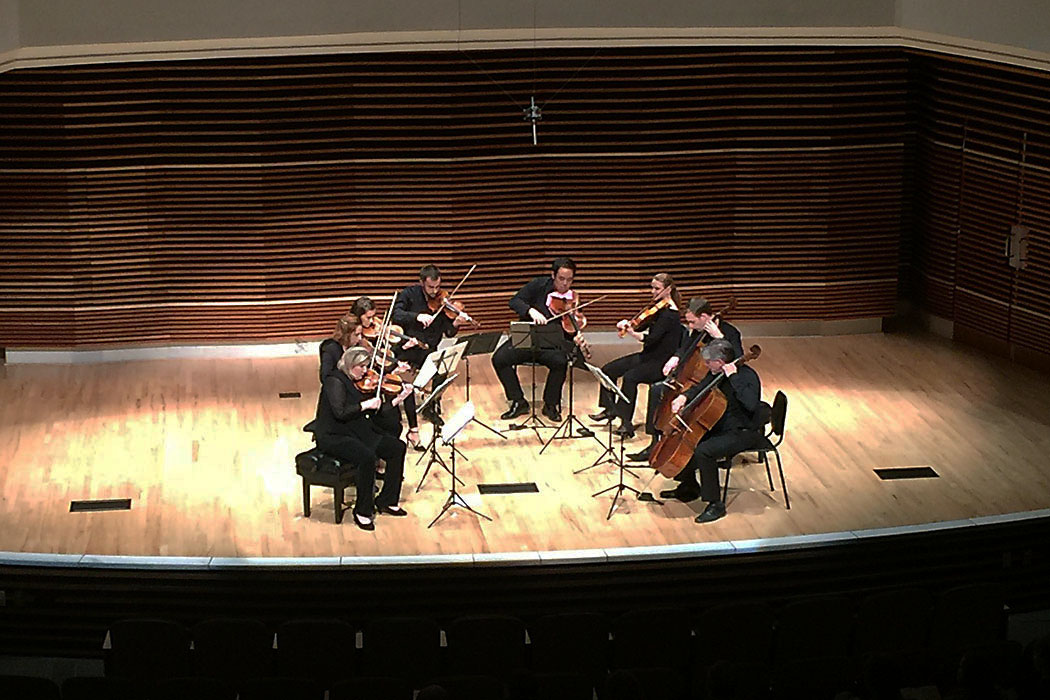One would be hard-pressed to find a work that is a greater example of the ideals of chamber music than Felix Mendelssohn’s Octet in E-flat, Op. 20. At the age of 16 in 1825, the young Mendelssohn turned out a work that is a precocious masterpiece displaying both an uncanny grasp of engaging melodies and a brilliant sense of ensemble construction. Mendelssohn wrote the octet as a birthday gift for his friend and violin teacher, Eduard Rietz, with the work receiving its first performance in what was an ideal chamber music setting—a private family gathering in the Mendelssohn’s home in Berlin.
Those ideals of chamber music performance—sans a family parlor—were on display Wednesday evening at UT School of Music’s Sandra G. Powell Recital Hall as the Cavani String Quartet wrapped up their artists-in-residence stint and were joined by a faculty ensemble for the Mendelssohn Octet. The Quartet currently consists of violinists Annie Fullard and Catherine Cosbey, violist Eric Wong, and cellist Kyle Price. The UTKSOM ensemble members were faculty members Geoff Herd, violin; Hillary Herndon, viola; and Wesley Baldwin, cello. Rounding out the octet was UTKSOM student violinist Clarice Collins.
In this vibrantly impressive and dynamic performance, the eight worked well together, at times even explosively, taking Ms. Fullard’s often aggressive and continually energetic first violin lead and infusing the passagework with agile conversational echoes and retorts that alternately sparkled and blended.
The first half of the evening was one of compellingly connected pieces, first the Beethoven String Quartet, Op. 18, No. 6, followed by Caroline Shaw’s 2016 work, Blueprint.
Ms. Shaw, winner of the Pulitzer Prize for Music in 2013 for Partita for 8 Voices and a Grammy this year for the Attacca Quartet’s recording of Orange, has described Blueprint as a “harmonic reduction” of the Beethoven Op. 18, No. 6 quartet. Hearing the pieces back-to-back was exhilarating and revelatory for one’s admiration of both.
In the Beethoven, the quartet took lively tempos without rushing, allowing the first movement’s conversational moments the proper amount of push and pull, conversations that continued in the Adagio. Throughout, the ensemble offered drama with warmth and stability, the drama coming generally in hyperbolic statements in Fullard’s first violin. In the finale movement, the contrasts of the slower, if not pensive, ‘La Malinconia’ to the ensuing Allegretto, were a brilliant one-two delivery.
With Shaw’s Blueprint coming in at six minutes or so, it felt at first like a humorous summation of the Beethoven quartet. But this re-imagining was a light-heartedness that evolved brilliantly into seriousness with repetitions and a tonality that slides magically in and out of delicious dissonances. While Beethoven wrapped up his Allegretto with an energetic surge, Shaw’s final statement is a gentle and marvelous nose-tweak to those who had been taking it a bit too seriously. The Cavani’s clever interpretation of Shaw’s intent made the performance magical and smile-inducing.








